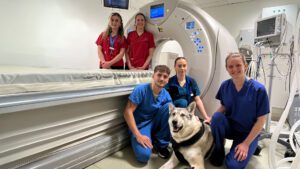Methods
Anatomical data were collected from a prospectively recruited population of 27 dogs using a previously validated method of optimal safe implantation corridor analysis using computed tomographic images.
Results
Optimal implant positions and three-dimensional numerical data were generated successfully in all cases. Anatomical landmarks could be used to generate objective definitions of optimal insertion points which were applicable across all three groups. Overall the geometrical distribution of all implant sites was similar in all three groups with a few exceptions.
Summary
Ventral atlantoaxial stabilization techniques are challenging surgical procedures in dogs. Available surgical guidelines are based upon subjective anatomical landmarks, and limited radiographic and computed tomographic data. The aims of this study were (1) to provide detailed anatomical descriptions of atlantoaxial optimal safe implantation corridors to generate objective recommendations for optimal implant placements and (2) to compare anatomical data obtained in non-affected Toy breed dogs, affected Toy breed dogs suffering from atlantoaxial instability and non-affected Beagle dogs.












